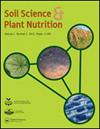Abstracts of Nippon Dojo-Hiryogaku Zasshi 93 - 1
IF 1.8
4区 农林科学
Q3 ENVIRONMENTAL SCIENCES
引用次数: 0
Abstract
The effects of nitrogen, phosphorus, and potassium deficiency and the continuous application of organic matter on paddy rice yield were examined in relation to the nutrient balance and changes in soil chemistry that were recorded over a period of 95 years, i.e., since 1926. The experiment consisted of the following nine treatment plots: NPK (complete), NF (non-fertilized), -N (non-nitrogen), -P (non-phosphorus), -K (non-potassium), +RSC750 (NPK+rice straw compost, 750 g m −2 ), +RSC2250 (NPK+rice straw compost, 2250 g m −2 ), NPK-Ca (NPK without slaked lime), and NF-Ca (non-fertilized and without slaked lime). The rice grain yield among various treatment plots was arranged in the following order: (NF-Ca, NF, -P)<-N<(-K, NPK-Ca, NPK)<+RSC750<+RSC2250. The yield ratios of the NF, -P, -N, and -K plots to the NPK plot were 0.27, 0.33, 0.44, and 0.94, respectively. Rice straw compost application increased the grain yield by 1.17 times for +RSC750 and by 1.31 times for +RSC2250 as compared with the NPK plot. Potassium balance was negative in the NF, NF-Ca, -K, NPK, NPK-Ca, and +RSC750 plots. Total soil potassium, exchangeable potassium, and nonexchangeable potassium concentrations were stable for the last 45 years (since 1976), despite the negative potassium balance. Although total potassium concentration in each experimental plot was almost equal, exchangeable potassium and nonexchangeable potassium concentrations differed depending on the treatment, reflecting potassium balance. These findings suggest that potassium dynamics in this paddy field have already reached equilibrium and that weathering of soil minerals is an important source of potassium for crop yield. In addition, potassium fertility in this paddy field is considered to be very persistent because the decrease in yield in the -K plot was lower than that in the NPK plot over 95 years. C of released CO 2 (to calculate primed carbon), and soil pH were periodically measured. After 60 days, the amount of primed carbon was −31.8, −56.9, −43.9, and 8.4 mg C kg −1 in the R, R+ FA5, R+ FA10, and R+ FA20 plots, respectively. Soil pH after 60 days were 4.5, 4.6, 5.0, 5.3, and 5.9 in the C, R, R+ FA5, R+ FA10, and R+ FA20 plots, respectively. These results indicated that 20% (w/w) fly ash application sig-nificantly ameliorated soil pH, led to a positive priming effect, and promoted the decomposition of native soil organic carbon. On the other hand, 5% and 10% (w/w) fly ash applications only slightly, but significantly, ameliorated soil pH ranges from 4.6 to 5.0 and 5.3, respectively, causing a negative priming effect similar to that observed in the R plot. To predict present-day soil distribution in Japan, it is necessary to clarify the effects of landform, land improvement, and land-use changes on soil class because many agricultural fields have experienced anthropogenic activities since the original agricultural soil maps were created. For this purpose, we compared the previous soil profiles of a paddy field in Shiga prefecture with the results of a present-day simple soil profile survey. The results of this survey revealed that Gley lowland soils were distributed in a valley bottom plain, regardless of soil class, before land improvement and associated soil movement due to normal water addition from a nearby forested area. Although there was no relationship between soil classes in the delta landform, the soil class changed after the introduction of a drainage system and subsequent land-use changes. Gley lowland soils that occurred in the delta before land improvement were subsequently altered to other soil classes. Some soils provided good drainage in the delta before the land became a lowland-paddy soil area by paddy soil-forming processes over more than 50 years. In conclusion, although land improvement and land-use changes had a significant impact on the agricultural field surveyed, we are still able to predict modern soil distribution by considering current landforms and past soil conditions.《日本道州-平日化报》93 - 1摘要
从1926年以来95年的土壤养分平衡和土壤化学变化记录中,研究了氮、磷、钾缺乏和连续施用有机质对水稻产量的影响。试验包括9个处理区:NPK(完全)、NF(不施肥)、-N(不施肥)、-P(不施肥)、-K(不施肥)、+RSC750 (NPK+稻草堆肥,750 g m−2)、+RSC2250 (NPK+稻草堆肥,2250 g m−2)、NPK- ca(不施肥、不施肥)和NF- ca(不施肥、不施肥)。各处理区水稻产量排列顺序为:(NF- ca, NF, -P)<-N<(-K, NPK- ca, NPK)<+RSC750<+RSC2250。NF、-P、-N和-K与NPK的产量之比分别为0.27、0.33、0.44和0.94。水稻秸秆堆肥处理与氮磷钾处理相比,+RSC750处理增产1.17倍,+RSC2250处理增产1.31倍。NF、NF- ca、-K、NPK、NPK- ca和+RSC750小区钾平衡为负。土壤全钾、交换性钾和非交换性钾浓度在近45年(1976年以来)保持稳定,但存在负钾平衡。虽然各试验田总钾浓度基本相等,但不同处理的交换性钾和非交换性钾浓度不同,反映了钾平衡。这些结果表明,该水田的钾动态已经达到平衡,土壤矿物质的风化作用是作物产量钾的重要来源。此外,该稻田的钾肥力被认为是非常持久的,因为在95年的时间里,-K地块的产量下降幅度低于NPK地块。定期测定co2释放量C(计算底质碳)和土壤pH值。60 d后,R区、R+ FA5区、R+ FA10区和R+ FA20区引碳量分别为- 31.8、- 56.9、- 43.9和8.4 mg C kg - 1。C、R、R+ FA5、R+ FA10和R+ FA20样地60 d后土壤pH分别为4.5、4.6、5.0、5.3和5.9。结果表明,施用20% (w/w)粉煤灰显著改善了土壤pH值,导致了正启动效应,促进了土壤原生有机碳的分解。另一方面,施用5%和10% (w/w)粉煤灰对土壤pH值的改善作用虽小,但效果显著,分别为4.6 ~ 5.0和5.3,引起了与R图相似的负启动效应。为了预测日本目前的土壤分布,有必要澄清地形、土地改良和土地利用变化对土壤类别的影响,因为自原始农业土壤地图创建以来,许多农业领域都经历了人为活动。为此,我们将滋贺县稻田以前的土壤剖面与当今简单土壤剖面调查的结果进行了比较。调查结果表明,在土地改良和附近森林地区正常水分补充之前,glley低地土壤分布在山谷底部平原,无论土壤等级如何。虽然三角洲地形的土壤类别之间没有关系,但在引入排水系统和随后的土地利用变化后,土壤类别发生了变化。在土地改良之前发生在三角洲地区的低洼土壤随后被改变为其他土壤类别。经过50多年的水稻土形成过程,在三角洲地区成为低地-水稻土区之前,一些土壤提供了良好的排水条件。综上所述,尽管土地改良和土地利用变化对所调查的农田产生了重大影响,但我们仍然能够通过考虑当前地形和过去土壤条件来预测现代土壤分布。
本文章由计算机程序翻译,如有差异,请以英文原文为准。
求助全文
约1分钟内获得全文
求助全文
来源期刊

Soil Science and Plant Nutrition
农林科学-农艺学
CiteScore
4.80
自引率
15.00%
发文量
56
审稿时长
18-36 weeks
期刊介绍:
Soil Science and Plant Nutrition is the official English journal of the Japanese Society of Soil Science and Plant Nutrition (JSSSPN), and publishes original research and reviews in soil physics, chemistry and mineralogy; soil biology; plant nutrition; soil genesis, classification and survey; soil fertility; fertilizers and soil amendments; environment; socio cultural soil science. The Journal publishes full length papers, short papers, and reviews.
 求助内容:
求助内容: 应助结果提醒方式:
应助结果提醒方式:


